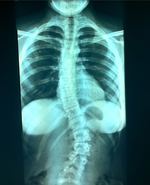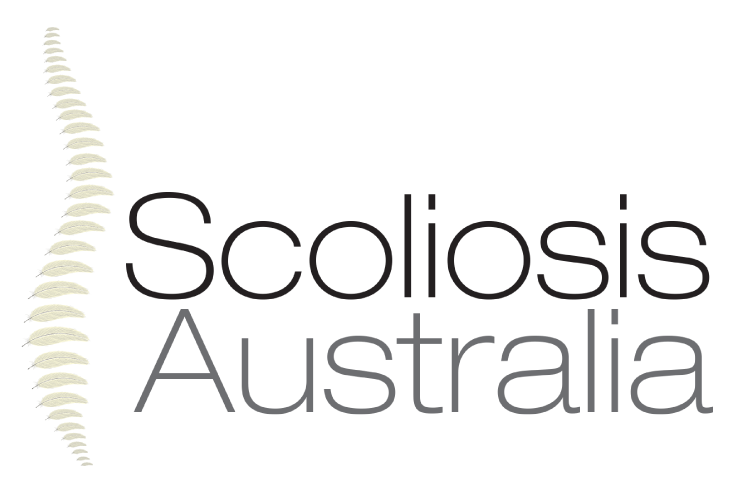Belle’s Story
16 years of age at surgery
Thoracolumbar curve – 46 degrees
When I was 15, I had an x-ray of the lungs for possible pneumonia (which I didn’t have) and that showed up the curve in my spine. I had had a lack of symmetry in my hips for many years, from about 12 years old, and had asked my GP about it, but he never suggested anything like scoliosis. My mum took me to an osteopath but he said it was muscular, and gave me exercises to stretch my muscles along one side. It didn’t cure the right hip sticking out more than the left, and still no one mentioned scoliosis. Lots of times since the diagnosis, people have asked didn’t your school do scoliosis checks, and the answer for me, is no.
After the x-ray, my mum did some research and found a couple of names of doctors who she thought it would be good to see. The first specialist we saw said he thought surgery would be necessary at some point in my life but first he got me to have some full length spine x-rays (the pneumonia ones just showed my upper body) and they showed up a really big curve. The specialist said it was within the surgical operation range but said as it wasn’t something that was really, really urgent, we should wait another six months and have more x-rays so we could monitor the situation. The next set of x-rays showed the curve had become slightly worse. Again, the surgeon said it wasn’t a question of having to have surgery straight away, but that he thought it would be good to have it done within the next couple of years. He thought if I didn’t get surgery fairly soon I would get more back pain as I got older and that the discs would degenerate more over time and that I would end up having to have surgery in my 30s. He suggested we go home and think about what I wanted to do. Mum organized a second opinion because it was such a big decision to make on the strength of one opinion, which confirmed the first. Also, the second surgeon suggested that I should have anterior surgery, not have the incision for the surgery down my back. He said the scar would hardly be noticeable because usually my arm would cover it. But also he said it was a good alternative for me because of the location of the curve.
Because I was at the beginning of Year 11 and didn’t want to wait for another year and a half, we decided to get the surgery done as soon as possible. The date was set for about 7 weeks later.
Before the surgery, I tried to avoid thinking about it, which made it a lot scarier right before I went in. Even though I had a lot of faith in my surgeon, I did worry about there being complications. It sounds strange, but before surgery the pain issue didn’t really occur to me.
When I woke up in intensive care, they kept asking me to wiggle my toes, which I could do. That was a relief because it meant I wasn’t paralysed! But I was not really able to move and was on lots of medication. I asked Mum to take a photo of my hips, so that I could see they were symmetrical. I was very happy about that! The nurses in intensive care were really good and nice. Intensive care is very noisy, you might like to know.
My back was fused between T11 and L3. The doctor said that unless I wanted to be a gymnast or an Olympic athlete, it shouldn’t affect my life. So, no problem there.
I was sleeping a lot because of the pain medication, and so I found that watching movies was the best thing because I didn’t have to engage very much or hold a book up for a long time. Plus if you fell asleep it was easy to back track. But an ipod could be good too, it depends on what you like best.
On day 2, when I tried to stand I was shocked at how weak I was, and that is something I think would be helpful to know in advance if you are having this surgery. It was really hard for me to walk not only because it hurt but because I felt so fragile. It does get a lot easier, although that can be difficult to remember while it’s happening.
Another thing to remember, a bit later on, is not to underestimate yourself, and don’t be afraid to move as normally as you can. Your stitches will not rip. I was walking around without support by the last couple of days in hospital, but still very slowly and not for far. As much as you do not want to walk around and do the exercises, grit your teeth and do it! It’s silly to not help yourself recover in every way you can and your back often hurts more the less you move cause you get all stiff.
Mum took me home in our car, which is quite small. We put all the seats as far back as possible for me, and you just need to fiddle with it until the seat is at comfortable position for you and one that’s easy to reach, and go slowly! I also put a towel around my scar and held it there, makes it hurt less when you go over bumps in the road.
I was very dependent on the Oxycontin and Panadol for at least four weeks, but especially for the first two weeks. We left hospital the day before Good Friday and the supplies the hospital gave us ran out too soon. On Easter Monday. It wasn’t easy for Mum to get more supplies (the hospital wouldn’t supply) and she had to get a doctor called to the house to write the prescription for me. (Just saying, make sure you have enough drugs!)
It was nice, but a little bit scary to be home (away from the care in the hospital). We put a little stool in the shower because I got incredibly tired really quickly so standing up for a long time was really hard. I would hold a pillow against my scar whenever I coughed/laughed/sneezed, anything where you tense those muscles and it hurts, and that was really helpful with absorbing the pain and stuff. I got bored of sleeping on my back so to make it more comfortable to lie on my side I would put a pillow in between my knees which helps distribute weight or something.
I was unlucky because I developed a lung infection two weeks after my surgery so that did set back my recovery time a lot, one of the biggest side effects of pneumonia being exhaustion so it was harder for me to get back into walking.
While writing this I’m about three months after surgery, and I still get some back/rib pains and my stomach is still a little numb but apart from that I feel basically normal. The numb stomach was not something I remember being told about before the operation, but the surgeon says it will come back – though it may take up to a year.
I’m really happy that I had the surgery. I had been very self conscious of the way my hip stuck out and being able to just whip my shirt off at the beach or something makes me really happy. The trade for even hips with a scar is definitely worth it to me. It really affected my confidence before, and I feel really good about my body now.
Belle’s x-rays


with screws in the vertebral bodies and small cages at L1/2 and L2/3
which help reconstitute the normal “sway” of the low back.
This is seen well on image 3 below, the lateral projection.

Following are some comments by Dr Scoliosis.
Belle’s story is instructive and highlights a few points:-
- Don’t be afraid to seek out a second opinion. This can be helpful to you the patient, your family and also your surgeon. Sometimes it can be very helpful that another doctor agrees with the recommendations you have received. The decision to proceed to surgery, timing and type of surgery might all be questioned. Talking to other patients can also be helpful
- Surgery and the early postoperative phase can be uncomfortable despite all our attempts to make it easier. Websites, handouts and talking to your doctor and other patients can all help prepare you.
- Typically in the early postoperative period you will have various pain relieving medications, maybe including a morphine infusion that you control yourself with a button and possibly also an infusion directed in around the spine called an epidural or paravertebral catheter. Ask your doctor about these. The doctors and nurses will monitor your blood pressure, pulse and breathing and will frequently ask you to move your toes to make sure that everything is working normally especially in the first 24 hours after surgery.
- Make sure you have enough pain medications when you leave hospital especially around holiday periods when accessing further medication might be difficult and most importantly, do your breathing exercises when you get home. This cuts down the chance of breathing complications in the first two or three weeks after surgery. Sometimes bad luck occurs even in a motivated patient like Belle, but respiratory complications and indeed most postoperative problems are usually readily fixed.
- Most importantly, as in Belle’s case, the discomfort is usually worth it as fairly soon after the surgery, things return to normal. As Belle described “I feel really good about my body now”. This is the experience of most such teenagers having scoliosis surgery.
